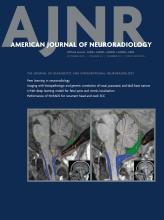Index by author
Yanagisawa, Takafumi
- EDITOR'S CHOICEHead & NeckYou have accessPerformance of Neck Imaging Reporting and Data System (NI-RADS) for Diagnosis of Recurrence of Head and Neck Squamous Cell Carcinoma: A Systematic Review and Meta-analysisAkira Baba, Ryo Kurokawa, Mariko Kurokawa, Takafumi Yanagisawa and Ashok SrinivasanAmerican Journal of Neuroradiology October 2023, 44 (10) 1184-1190; DOI: https://doi.org/10.3174/ajnr.A7992
Posttreatment follow-up imaging of head and neck cancer is challenging because of the anatomic complexity of the head and neck region and the operations and posttreatment effects of radiation and chemotherapy that mimic recurrent disease. The Neck Imaging Reporting and Data System (NI-RADS) provides standardized terminology, report structure, and evaluation categories to convey the degree of suspicion of recurrence in the interpretation of imaging studies. This meta-analysis found NI-RADS 3 (high suspicion) has a high diagnostic performance for detecting clinically significant recurrence.
Yang, Ming
- EDITOR'S CHOICEPediatricsOpen AccessDual-Layer Detector Head CT to Maintain Image Quality While Reducing the Radiation Dose in Pediatric PatientsZhengwu Tan, Lan Zhang, Xiaojie Sun, Ming Yang, Joyman Makamure, Hongying Wu and Jing WangAmerican Journal of Neuroradiology October 2023, 44 (10) 1212-1218; DOI: https://doi.org/10.3174/ajnr.A7999
Radiation exposure from CT scanning is of increasing concern as CT use in children has risen dramatically. This retrospective study of pediatric CT heads aimed to compare 60-keV with conventional images obtained with different acquisition protocols to evaluate whether a reduced radiation dose can be achieved in 60-keV without compromising image quality. On the basis of image analysis and observer agreement assessment, the authors found a dose reduction of 28% while maintaining superior image quality with a scan protocol of 180 mAs compared with 250 mAs on 60-keV virtual monoenergetic images from spectral detector CT in the pediatric head.
Yeom, H.G.
- FELLOWS' JOURNAL CLUBHead & NeckYou have accessDifferentiation between Chondrosarcoma and Synovial Chondromatosis of the Temporomandibular Joint Using CT and MR ImagingB.G. Jang, K.H. Huh, H.G. Yeom, J.H. Kang, J.E. Kim, H.J. Yoon, W.J. Yi, M.S. Heo and S.S. LeeAmerican Journal of Neuroradiology October 2023, 44 (10) 1176-1183; DOI: https://doi.org/10.3174/ajnr.A7980
As chondrosarcoma and synovial chondromatosis of the temporomandibular joint share overlapping clinical and histopathologic features, CT and MR imaging can be helpful to differentiate between the 2 entities. High-risk imaging features for chondrosarcoma include the following: lesion centered on the mandibular condyle, destruction of the mandibular condyle, no destruction/sclerosis of the articular eminence/glenoid fossa, infiltration into the tendon of the lateral pterygoid muscle, absent or stippled calcification, periosteal reaction, internal enhancement, and size of ≥30.5 mm.
Yi, W.J.
- FELLOWS' JOURNAL CLUBHead & NeckYou have accessDifferentiation between Chondrosarcoma and Synovial Chondromatosis of the Temporomandibular Joint Using CT and MR ImagingB.G. Jang, K.H. Huh, H.G. Yeom, J.H. Kang, J.E. Kim, H.J. Yoon, W.J. Yi, M.S. Heo and S.S. LeeAmerican Journal of Neuroradiology October 2023, 44 (10) 1176-1183; DOI: https://doi.org/10.3174/ajnr.A7980
As chondrosarcoma and synovial chondromatosis of the temporomandibular joint share overlapping clinical and histopathologic features, CT and MR imaging can be helpful to differentiate between the 2 entities. High-risk imaging features for chondrosarcoma include the following: lesion centered on the mandibular condyle, destruction of the mandibular condyle, no destruction/sclerosis of the articular eminence/glenoid fossa, infiltration into the tendon of the lateral pterygoid muscle, absent or stippled calcification, periosteal reaction, internal enhancement, and size of ≥30.5 mm.
Yoon, H.J.
- FELLOWS' JOURNAL CLUBHead & NeckYou have accessDifferentiation between Chondrosarcoma and Synovial Chondromatosis of the Temporomandibular Joint Using CT and MR ImagingB.G. Jang, K.H. Huh, H.G. Yeom, J.H. Kang, J.E. Kim, H.J. Yoon, W.J. Yi, M.S. Heo and S.S. LeeAmerican Journal of Neuroradiology October 2023, 44 (10) 1176-1183; DOI: https://doi.org/10.3174/ajnr.A7980
As chondrosarcoma and synovial chondromatosis of the temporomandibular joint share overlapping clinical and histopathologic features, CT and MR imaging can be helpful to differentiate between the 2 entities. High-risk imaging features for chondrosarcoma include the following: lesion centered on the mandibular condyle, destruction of the mandibular condyle, no destruction/sclerosis of the articular eminence/glenoid fossa, infiltration into the tendon of the lateral pterygoid muscle, absent or stippled calcification, periosteal reaction, internal enhancement, and size of ≥30.5 mm.








